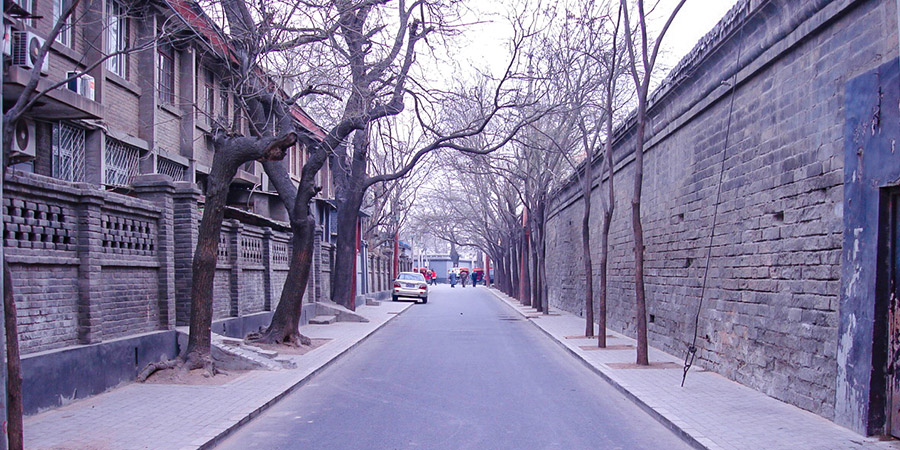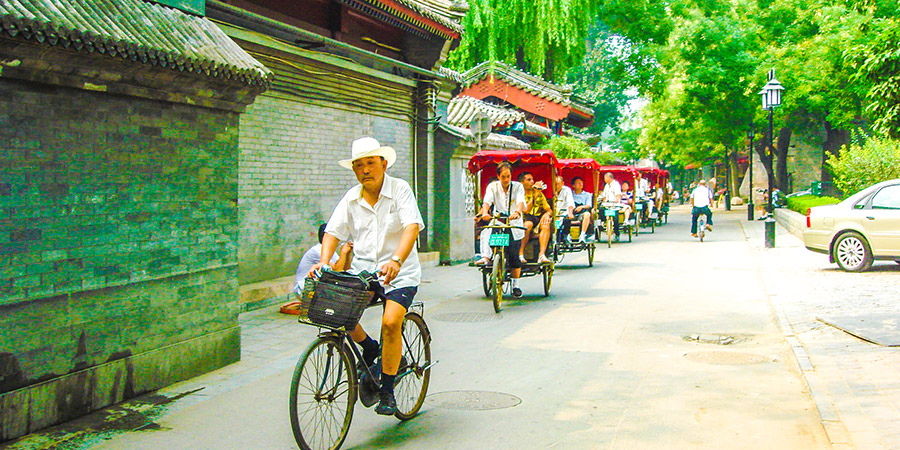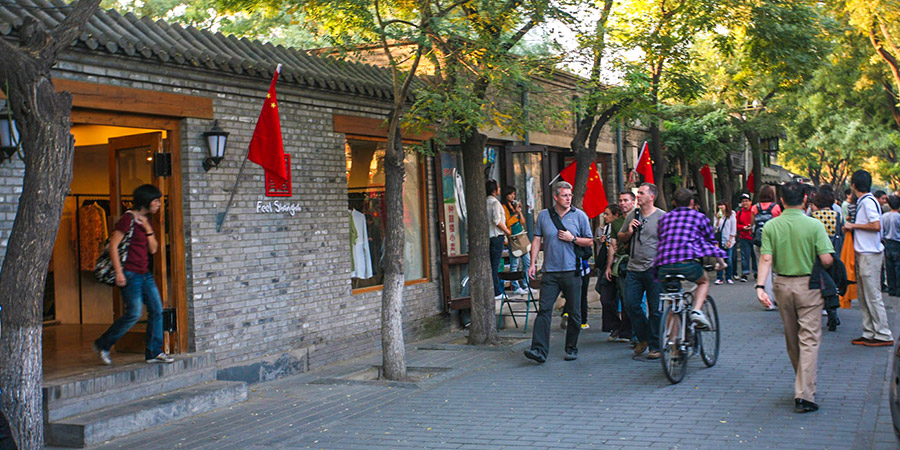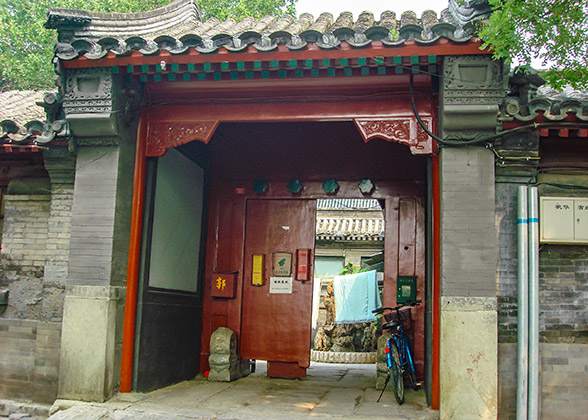Dongsi Hutongs
Dongsi Hutongs locate in the east part of Beijing. It consists of altogether 14 west-east hutong alleys, named Dongsi Toutiao (1st hutong alley), Dongsi Ertiao (2nd hutong alley)… till Dongsi Shisitiao (14th hutong alley). Not like in the famous Shichahai and Nanluoguxiang (South Gong and Drum Lane), most hutongs and courtyards here have not been renovated, but less commercialized and giving more traces of the past. The historical Hutongs were generally formed in the Yuan Dynasty (1271 - 1368). Later, in the Ming and Qing Dynasties (1368 - 1911), many royal members and celebrities once lived here.
Location: No.77, Dongsi Sitiao
It is inside a classic courtyard, where visitors can know more about the traditional folk residence at a close range. It has three rows of houses facing the south, and each row is accompanied with west and east wings. The decorations on the gate, roofs and windows are very delicate, displaying old Beijingers’ positive attitudes towards life. Here, you can also learn the history of Dongsi and folk culture via videos, pictures, old items and various models, etc.
Location: No.86, Dongsi Sitiao
This is a two-storey building adopting some western architectural elements, very unique among Chinese styles courtyards. It was a “shopping mall” 100 years ago, selling goods from western countries and leading the fashion trends back then. Customers could also take photos, enjoy delicious food and have other fun here.
Location: No.22, Dongsi Shitiao
These are the imperial granaries in the Ming and Qing Dynasties with a history of over 600 years and currently the only existing imperial granaries all over China. 9 of them have been preserved. Nowadays, a theme block has been built there to introduce the ancient ways of transporting and storing grains to the public.
Loation: No. 47, Dongsi Shiyitiao
Dongsi Shiyitiao Hutong was used to transport grains, so it is wider than other hutongs and it’s not surprising to find a grain store here. The stone plaque is still hanging there. But it is no longer selling grains, but a shop selling daily necessities.
Below are some famous sites in Dongsi Hutongs not open to tourists and you can only have a look from outside. If lucky, you may be allowed in by people working or living inside.
Location: No.137, Chaoyangmen Inner Street
Generally preserving its original layout and outlook, it is even larger than the well-known Prince Gong’s Mansion, extending for three Hutongs from Dongsi Toutiao in the south to Dongsi Santiao in the north. Its present front gate was built in the Republic of China in early 20th century, on Chaoyangmen Inner Street, the southern boundary of Dongsi Hutongs. It is now the offices of a few publishers and not open to tourists.
Location: No. 63 & 65, Dongsi Liutiao
This was once the largest and best folk residence in Dongsi Hutongs, even the whole east area of Beijing. Although it is not highly ranked as royal prince mansions, the residence is delicately built and decorated. Nowadays, it is shared by several families and not very well protected. Fortunately, not too many additional buildings have been added like in other folk residences and courtyards there.
Location: No.83, Dongsi Sitiao
This is the only existing ancient mint in Beijing. Nowadays, it is dwelled by several families and many extra architectures have been built, quite a mess. But its original layout can still be told apart.
Other than above places to see, here are also some recommended yards of famous historical figures.
 Dongsi 1st Alley: No. 1, 19, 37 Yards
Dongsi 1st Alley: No. 1, 19, 37 Yards
 Dongsi 2nd Alley: No.11, 13, 15
Dongsi 2nd Alley: No.11, 13, 15
 Dongsi 3rd Alley: No.35, 65, 67
Dongsi 3rd Alley: No.35, 65, 67
 Dongsi 4th Alley: No.1, 3, 5
Dongsi 4th Alley: No.1, 3, 5
 Dongsi 5th Alley: No.3
Dongsi 5th Alley: No.3
 Dongsi 6th Alley: No.6
Dongsi 6th Alley: No.6
 Dongsi 7th Alley: No.61, 77, 79
Dongsi 7th Alley: No.61, 77, 79
 Dongsi 8th Alley: No.71, 111
Dongsi 8th Alley: No.71, 111
 Dongsi 9th Alley: No.69
Dongsi 9th Alley: No.69
Take subway line 5 or line 6 to Dongsi, and then get out from exit B to find the Dongsi Hutongs to the north.
Many Buses would stop near Dongsi Hutongs, including 58, 84, 101, 106, 109, 110, 116, and 128. After getting off the bus, walk for minutes to get there.
It takes about half a day to tour the Dongsi Hutongs, so you can choose either morning or afternoon.
1. Many Hutongs are lived by local people, thus open all year around.
2. Some places don’t operate on some days, like Museum of Dongsi Hutongs on Tuesday and Thursday. You can check it in advance.
Free
The Dongsi Hutongs are not far from Sanlitun, a popular destination for colorful night life among youngsters. You can go there to have fun or have meals.
Lishi Hutong and Shijia Hutong are to the south of Dongsi Hutong. You can also watch ancient residences there. For example, Shijia Hutong has micro-models of 130 yards and displays the artifacts concerning the 20th century.
 |
| Dongsi Hutong |
Highlights in Dongsi Hutongs
1. Museum of Dongsi Hutongs
It is inside a classic courtyard, where visitors can know more about the traditional folk residence at a close range. It has three rows of houses facing the south, and each row is accompanied with west and east wings. The decorations on the gate, roofs and windows are very delicate, displaying old Beijingers’ positive attitudes towards life. Here, you can also learn the history of Dongsi and folk culture via videos, pictures, old items and various models, etc.
 |
| Rickshaw Service in Dongsi Hutongs |
2. Hengchangrui Store
This is a two-storey building adopting some western architectural elements, very unique among Chinese styles courtyards. It was a “shopping mall” 100 years ago, selling goods from western countries and leading the fashion trends back then. Customers could also take photos, enjoy delicious food and have other fun here.
 |
| Commercial Street Around Dongsi Hutongs |
3. Nanxin Granaries
These are the imperial granaries in the Ming and Qing Dynasties with a history of over 600 years and currently the only existing imperial granaries all over China. 9 of them have been preserved. Nowadays, a theme block has been built there to introduce the ancient ways of transporting and storing grains to the public.
4. Guanghecheng Grain Store
Dongsi Shiyitiao Hutong was used to transport grains, so it is wider than other hutongs and it’s not surprising to find a grain store here. The stone plaque is still hanging there. But it is no longer selling grains, but a shop selling daily necessities.
Below are some famous sites in Dongsi Hutongs not open to tourists and you can only have a look from outside. If lucky, you may be allowed in by people working or living inside.
5. Prince Fu’s Mansion
 |
| Traditional Residence in Beijing's Hutong |
Generally preserving its original layout and outlook, it is even larger than the well-known Prince Gong’s Mansion, extending for three Hutongs from Dongsi Toutiao in the south to Dongsi Santiao in the north. Its present front gate was built in the Republic of China in early 20th century, on Chaoyangmen Inner Street, the southern boundary of Dongsi Hutongs. It is now the offices of a few publishers and not open to tourists.
6. Chongli Residence
This was once the largest and best folk residence in Dongsi Hutongs, even the whole east area of Beijing. Although it is not highly ranked as royal prince mansions, the residence is delicately built and decorated. Nowadays, it is shared by several families and not very well protected. Fortunately, not too many additional buildings have been added like in other folk residences and courtyards there.
7. Baoquanju Mint (East Branch)
This is the only existing ancient mint in Beijing. Nowadays, it is dwelled by several families and many extra architectures have been built, quite a mess. But its original layout can still be told apart.
Other than above places to see, here are also some recommended yards of famous historical figures.
How to Get to Dongsi Hutongs
1. Subway
2. Bus
Recommended Visit Time
Opening hours
2. Some places don’t operate on some days, like Museum of Dongsi Hutongs on Tuesday and Thursday. You can check it in advance.
Ticket Price
Where Else to Go after Dongsi Hutongs Tour
1. Sanlitun
2. Lishi Hutong/ Shijia Hutong
- Last updated on Aug. 01, 2025 by Gabby Li -